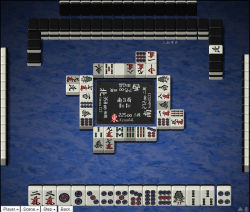Sanshoku doujun: Difference between revisions
No edit summary |
No edit summary |
||
| (4 intermediate revisions by 4 users not shown) | |||
| Line 9: | Line 9: | ||
* [http://tenhou.net/0/?log=2013111613gm-0009-7447-5dc14720&tw=0&ts=3 Closed sanshoku] with [[junchan]] | * [http://tenhou.net/0/?log=2013111613gm-0009-7447-5dc14720&tw=0&ts=3 Closed sanshoku] with [[junchan]] | ||
}} | }} | ||
'''Sanshoku doujun''' {{kana|三色同順}} is a | '''Sanshoku doujun''' {{kana|三色同順}} is a [[yaku]] scored when a hand has three [[sequence]]s, one of each suit, that share the same numbers. The shorthand '''sanshoku''' more commonly refers to this yaku, instead of the significantly more difficult to achieve [[sanshoku doukou]]. It is sometimes called '''sanshiki''' {{kana|さんしき}} in older media. | ||
==Tile pattern== | ==Tile pattern== | ||
| Line 15: | Line 15: | ||
{{#mjt:123m123p123678s1z}} Agari : {{#mjt:1z}} | {{#mjt:123m123p123678s1z}} Agari : {{#mjt:1z}} | ||
This hand contains | This hand contains a "123" sequence in each of the 3 numbered suits, scoring this yaku. Since this is a closed hand, sanshoku is worth 2 han. | ||
{{#mjt:123m123p123s1z}} {{#mjt:6'78s}} Agari : {{#mjt:1z}} | {{#mjt:123m123p123s1z}} {{#mjt:6'78s}} Agari : {{#mjt:1z}} | ||
| Line 21: | Line 21: | ||
{{#mjt:123p67s11z}} {{#mjt:1'23m}} {{#mjt:3'12s}} Agari : {{#mjt:8s}} or {{#mjt:5s}} | {{#mjt:123p67s11z}} {{#mjt:1'23m}} {{#mjt:3'12s}} Agari : {{#mjt:8s}} or {{#mjt:5s}} | ||
While having same tiles with the first example, these hands | While having same tiles with the first example, these hands were opened, so sanshoku is only valued at 1 han. | ||
== | == Compatibility == | ||
{{main|Yaku compatibility}} | |||
{{main|Yaku | |||
{{Yaku compatibility table|SDJ}} | {{Yaku compatibility table|SDJ}} | ||
Sanshoku requires three | Sanshoku requires three sequences, so it is incompatible with [[toitoi]], [[sanshoku doukou]], [[sanankou]], [[sankantsu]], [[shousangen]], [[honroutou]], and [[chiitoitsu]]. It requires three suits, so it is also incompatible with [[honitsu]] and [[chinitsu]]. Finally, sanshoku leaves no room to also score [[ryanpeikou]] or [[ittsu]]. | ||
===Takame and yasume=== | ===Takame and yasume=== | ||
{{main|Takame and yasume}} | {{main|Takame and yasume}} | ||
Sanshoku is particularly affected by [[takame and yasume]]. | Sanshoku is particularly affected by [[takame and yasume]]. When a hand has a [[ryanmen]] wait, and is waiting to complete the 3rd sequence needed for the sanshoku pattern, only one of the two winning tiles will produce sanshoku. | ||
:{{#mjt:456m456s45p22266z}} Agari: {{#mjt:3p}} or {{#mjt:6p}} | :{{#mjt:456m456s45p22266z}} Agari: {{#mjt:3p}} or {{#mjt:6p}} | ||
| Line 43: | Line 40: | ||
===Versus ittsu=== | ===Versus ittsu=== | ||
{{main|Ittsu vs sanshoku}} | |||
[[Image:Ittsu sanshoku.png|thumb|right|250px|Both ittsu and sanshoku are [http://tenhou.net/0/?log=2015012320gm-0089-0000-5a33fc94&tw=2&ts=8 apparent].]] | [[Image:Ittsu sanshoku.png|thumb|right|250px|Both ittsu and sanshoku are [http://tenhou.net/0/?log=2015012320gm-0089-0000-5a33fc94&tw=2&ts=8 apparent].]] | ||
Before reaching [[tenpai]], it is possible for a hand to develop into both ittsu and sanshoku. However, there is no room for both yaku to exist. When both yaku are possible, then players will eventually need to decide which one to aim for. | |||
==Value== | |||
This yaku is subject to [[kuisagari]]. When closed, the yaku is worth 2 hand, but it is reduced to 1 han when open. | |||
==External links== | ==External links== | ||
Latest revision as of 19:13, 22 August 2024
| Type | Yaku |
|---|---|
| Kanji | 三色同順 |
| English | Three colored straight |
| Value |
2 han (closed) 1 han (open) |
| Speed | Medium |
| Difficulty | Medium |
Sanshoku doujun 「三色同順」 is a yaku scored when a hand has three sequences, one of each suit, that share the same numbers. The shorthand sanshoku more commonly refers to this yaku, instead of the significantly more difficult to achieve sanshoku doukou. It is sometimes called sanshiki 「さんしき」 in older media.
Tile pattern
This hand contains a "123" sequence in each of the 3 numbered suits, scoring this yaku. Since this is a closed hand, sanshoku is worth 2 han.
While having same tiles with the first example, these hands were opened, so sanshoku is only valued at 1 han.
Compatibility
^ Ippatsu requires riichi to be of any use.
| RCH | DRI | IPP | SMO | TAN | PFU | IPK | ITT | YAK | SDJ | SDO | TOI | SNA | SNK | CHA | JUN | RPK | SSG | HRO | HON | CHN | CHI | RIN | HAI | HOU | CHK | |
| SDJ |
Sanshoku requires three sequences, so it is incompatible with toitoi, sanshoku doukou, sanankou, sankantsu, shousangen, honroutou, and chiitoitsu. It requires three suits, so it is also incompatible with honitsu and chinitsu. Finally, sanshoku leaves no room to also score ryanpeikou or ittsu.
Takame and yasume
Sanshoku is particularly affected by takame and yasume. When a hand has a ryanmen wait, and is waiting to complete the 3rd sequence needed for the sanshoku pattern, only one of the two winning tiles will produce sanshoku.
Only the 6-pin produces sanshoku in this case.
Versus ittsu

Before reaching tenpai, it is possible for a hand to develop into both ittsu and sanshoku. However, there is no room for both yaku to exist. When both yaku are possible, then players will eventually need to decide which one to aim for.
Value
This yaku is subject to kuisagari. When closed, the yaku is worth 2 hand, but it is reduced to 1 han when open.
External links
- Sanshoku doujun in Japanese Wikipedia
| |||||||||||||||||||||||||||||||
